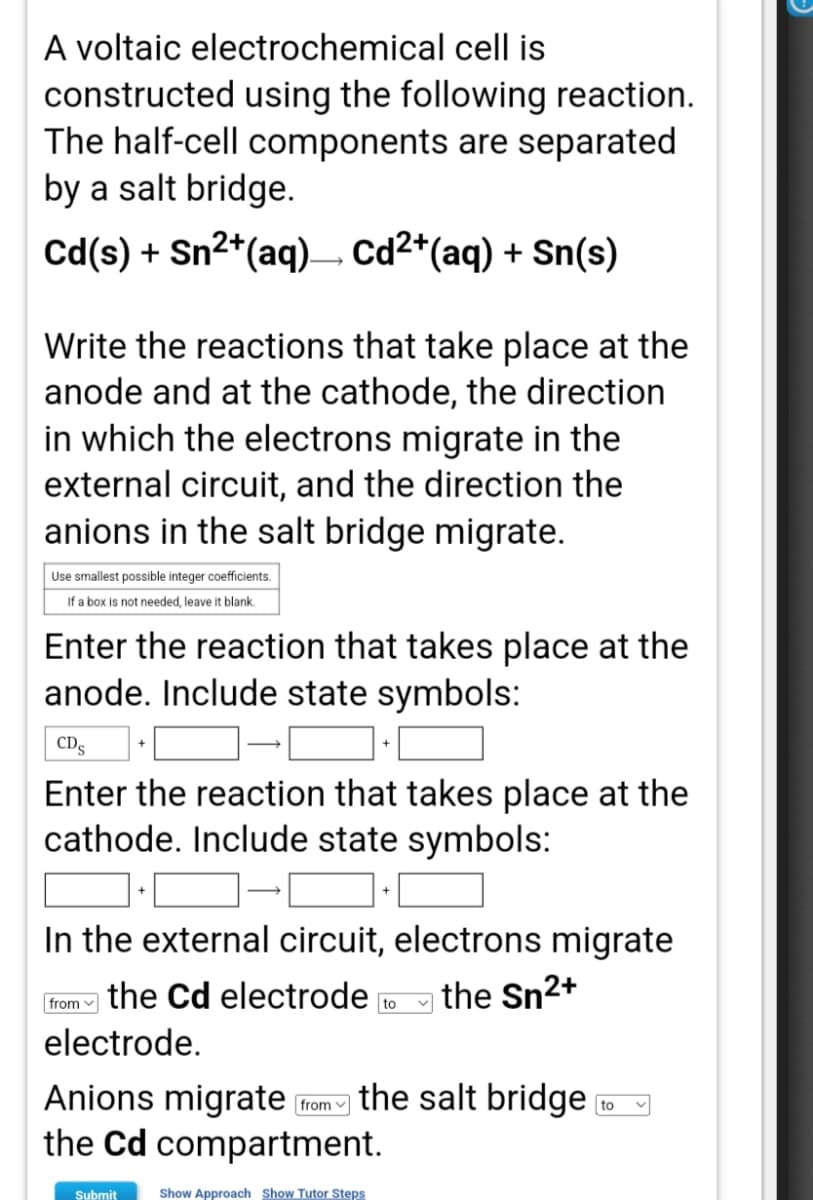A voltaic electrochemical cell is constructed using the following reaction. The half-cell components are separated by a salt bridge. Cd(s) + Sn2*(aq)– Cd²*(aq) + Sn(s) Write the reactions that take place at the anode and at the cathode, the direction in which the electrons migrate in the external circuit, and the direction the anions in the salt bridge migrate. Use smallest possible integer coefficients. If a box is not needed, leave it blank. Enter the reaction that takes place at the anode. Include state symbols: CDs Enter the reaction that takes place at the cathode. Include state symbols: In the external circuit, electrons migrate the Cd electrode the Sn2+ from v to electrode. Anions migrate the Cd compartment. (from v the salt bridge to Submit Show Approach Show Tutor Steps
A voltaic electrochemical cell is constructed using the following reaction. The half-cell components are separated by a salt bridge. Cd(s) + Sn2*(aq)– Cd²*(aq) + Sn(s) Write the reactions that take place at the anode and at the cathode, the direction in which the electrons migrate in the external circuit, and the direction the anions in the salt bridge migrate. Use smallest possible integer coefficients. If a box is not needed, leave it blank. Enter the reaction that takes place at the anode. Include state symbols: CDs Enter the reaction that takes place at the cathode. Include state symbols: In the external circuit, electrons migrate the Cd electrode the Sn2+ from v to electrode. Anions migrate the Cd compartment. (from v the salt bridge to Submit Show Approach Show Tutor Steps
Principles of Modern Chemistry
8th Edition
ISBN:9781305079113
Author:David W. Oxtoby, H. Pat Gillis, Laurie J. Butler
Publisher:David W. Oxtoby, H. Pat Gillis, Laurie J. Butler
Chapter17: Electrochemistry
Section: Chapter Questions
Problem 76AP
Related questions
Question

Transcribed Image Text:A voltaic electrochemical cell is
constructed using the following reaction.
The half-cell components are separated
by a salt bridge.
Cd(s) + Sn2*(aq)– Cd2*(aq) + Sn(s)
Write the reactions that take place at the
anode and at the cathode, the direction
in which the electrons migrate in the
external circuit, and the direction the
anions in the salt bridge migrate.
Use smallest possible integer coefficients.
If a box is not needed, leave it blank.
Enter the reaction that takes place at the
anode. Include state symbols:
CDs
Enter the reaction that takes place at the
cathode. Include state symbols:
In the external circuit, electrons migrate
from v the Cd electrode
electrode.
the Sn2+
to
Anions migrate
the Cd compartment.
(from the salt bridge
to
Submit
Show Approach Show Tutor Steps
Expert Solution
This question has been solved!
Explore an expertly crafted, step-by-step solution for a thorough understanding of key concepts.
Step by step
Solved in 2 steps with 1 images

Knowledge Booster
Learn more about
Need a deep-dive on the concept behind this application? Look no further. Learn more about this topic, chemistry and related others by exploring similar questions and additional content below.Recommended textbooks for you

Principles of Modern Chemistry
Chemistry
ISBN:
9781305079113
Author:
David W. Oxtoby, H. Pat Gillis, Laurie J. Butler
Publisher:
Cengage Learning

Chemistry: The Molecular Science
Chemistry
ISBN:
9781285199047
Author:
John W. Moore, Conrad L. Stanitski
Publisher:
Cengage Learning

Chemistry: Principles and Practice
Chemistry
ISBN:
9780534420123
Author:
Daniel L. Reger, Scott R. Goode, David W. Ball, Edward Mercer
Publisher:
Cengage Learning

Principles of Modern Chemistry
Chemistry
ISBN:
9781305079113
Author:
David W. Oxtoby, H. Pat Gillis, Laurie J. Butler
Publisher:
Cengage Learning

Chemistry: The Molecular Science
Chemistry
ISBN:
9781285199047
Author:
John W. Moore, Conrad L. Stanitski
Publisher:
Cengage Learning

Chemistry: Principles and Practice
Chemistry
ISBN:
9780534420123
Author:
Daniel L. Reger, Scott R. Goode, David W. Ball, Edward Mercer
Publisher:
Cengage Learning

Chemistry & Chemical Reactivity
Chemistry
ISBN:
9781133949640
Author:
John C. Kotz, Paul M. Treichel, John Townsend, David Treichel
Publisher:
Cengage Learning

Chemistry & Chemical Reactivity
Chemistry
ISBN:
9781337399074
Author:
John C. Kotz, Paul M. Treichel, John Townsend, David Treichel
Publisher:
Cengage Learning

Chemistry: An Atoms First Approach
Chemistry
ISBN:
9781305079243
Author:
Steven S. Zumdahl, Susan A. Zumdahl
Publisher:
Cengage Learning